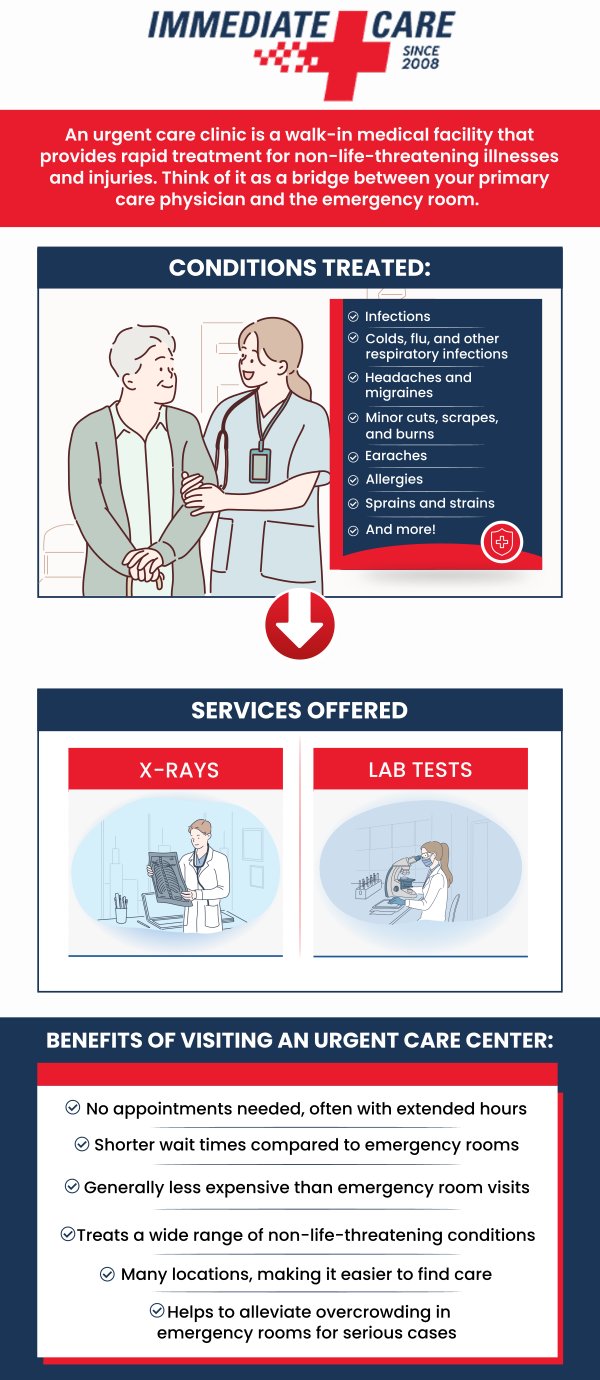Urgent Care: Linking the Gap Between Health Care and Emergency Areas
Immediate treatment centers have actually arised as important elements in the health care continuum, properly addressing the needs of clients who need instant medical interest for non-life-threatening conditions. The landscape of urgent care is complex, with unique differences from both main care and emergency services.
What Is Urgent Care?
Immediate treatment stands for a crucial component of the medical care system, providing immediate clinical focus for non-life-threatening problems that need timely treatment. These facilities are created to connect the gap between primary treatment providers and emergency departments, allowing patients to obtain prompt therapy without the prolonged wait times frequently associated with emergency situation areas.
Immediate treatment centers normally run outside of standard office hours, fitting patients throughout weekend breaks and evenings. They are staffed by healthcare professionals, consisting of doctors, nurse specialists, and physician aides, that are trained to detect and treat a variety of clinical problems - urgent care fresno. Usual problems treated at immediate care facilities consist of minor cracks, strains, infections, allergic responses, and minor cuts calling for stitches
The availability of urgent treatment services has actually made them a popular selection for individuals looking for immediate alleviation from acute clinical issues. This version not only alleviates stress on emergency divisions but additionally promotes an extra efficient use healthcare resources. By providing a practical choice for non-emergency circumstances, immediate care plays a vital duty in enhancing general individual care and enhancing wellness outcomes for areas.
When to Use Urgent Treatment,##.
Recognizing when to utilize urgent care can significantly affect individual end results and resource allowance within the medical care system. Urgent care facilities are created to attend to non-life-threatening clinical concerns that call for prompt focus but do not necessitate the resources of an emergency room.
Clients must think about checking out immediate treatment for conditions such as minor fractures, sprains, cuts needing stitches, and mild to moderate health problems like influenza signs, infections, or allergies. Furthermore, urgent care appropriates for analysis solutions, such as X-rays and laboratory tests, which can offer timely results for usual disorders.
It is vital to compare situations that require immediate treatment and those that need emergency services. Extreme injuries, upper body pain, difficulty breathing, or signs of stroke need to trigger instant emergency clinic sees. Recognizing these differences can result in more reliable use healthcare sources, lowering wait times in emergency divisions and making certain that those in essential demand get prompt treatments.
Benefits of Urgent Treatment
Accessing immediate care supplies numerous benefits for patients looking for prompt clinical attention. Immediate treatment facilities are created to accommodate clients with non-life-threatening problems, allowing for quicker diagnosis and treatment.

Cost-effectiveness is an additional significant advantage. Immediate treatment visits usually sustain reduced out-of-pocket expenses than emergency space sees, making it an extra economically feasible alternative for people. Many urgent care facilities accept a large range of insurance policy strategies, further relieving the monetary concern.
Furthermore, urgent care centers are furnished to manage a range of problems, from minor injuries to typical diseases, offering detailed care in a solitary place. This multi-faceted method not only simplifies the individual experience but likewise promotes continuity of care, boosting overall wellness end results.
Distinctions From Medical Care
Often forgotten, the differences between urgent treatment resource and main treatment are crucial for individuals navigating their medical care choices. Urgent treatment facilities largely attend to immediate, non-life-threatening clinical issues that call for timely focus, such as minor injuries, infections, and illnesses. These facilities usually run outside of normal office hours and do not call for visits, making them a hassle-free option for people who require quick help.
On the other hand, medical care carriers concentrate on thorough, ongoing wellness management. They develop lasting relationships with individuals, overseeing precautionary treatment, chronic illness monitoring, and regular health testings. Medical care highlights connection of care, permitting for customized therapy plans and extensive wellness assessments that urgent care setups can not give.
Additionally, health care medical professionals commonly coordinate references to specialists and maintain comprehensive clinical backgrounds, which is essential for managing complex health problems gradually. While immediate treatment can properly resolve acute concerns, it ought to not replace the here foundational role of main care in overall health administration. urgent care fresno. Comprehending these differences helps clients make informed decisions about where to seek care based on their specific health demands
Distinctions From Emergency Clinic
When to check out an urgent care center versus an emergency situation space,Clients in some cases find themselves uncertain concerning. Comprehending the essential differences can assist in making the appropriate option for their healthcare requires.

On the other hand, emergency rooms are outfitted to deal with lethal and vital problems, such as serious injury, heart assaults, or strokes. Patients experiencing signs that pose a prompt risk to their health and wellness should look for treatment at an emergency area. Emergency divisions are staffed with specialized medical employees and possess innovative diagnostic tools to take care of complex situations.
An additional considerable distinction hinges on the cost and wait times. Immediate treatment gos to often tend to be more budget friendly and involve much shorter delay times contrasted to emergency spaces, which usually experience high client quantities. Inevitably, understanding these distinctions equips people to make informed decisions, ensuring they get prompt and suitable treatment.
Verdict
Finally, see this urgent care offers a critical role in the health care system by supplying prompt clinical focus for non-life-threatening problems. Its accessibility, extended hours, and cost-effectiveness position it as an important resource for clients seeking instant care. By efficiently connecting the space between medical care and emergency services, urgent care centers aid to alleviate the strain on emergency divisions, making certain that people obtain reliable and ideal therapy without unneeded delays.
The landscape of urgent treatment is intricate, with unique differences from both primary treatment and emergency situation services. By offering a convenient choice for non-emergency circumstances, urgent care plays an essential function in improving overall person treatment and improving health end results for neighborhoods.
Frequently overlooked, the differences between immediate treatment and primary treatment are vital for clients browsing their health care options. Key care stresses continuity of treatment, enabling for individualized treatment plans and thorough wellness evaluations that urgent treatment setups can not provide.
By properly linking the space between main care and emergency situation services, immediate care facilities aid to ease the strain on emergency situation departments, making certain that clients obtain suitable and reliable therapy without unnecessary hold-ups.